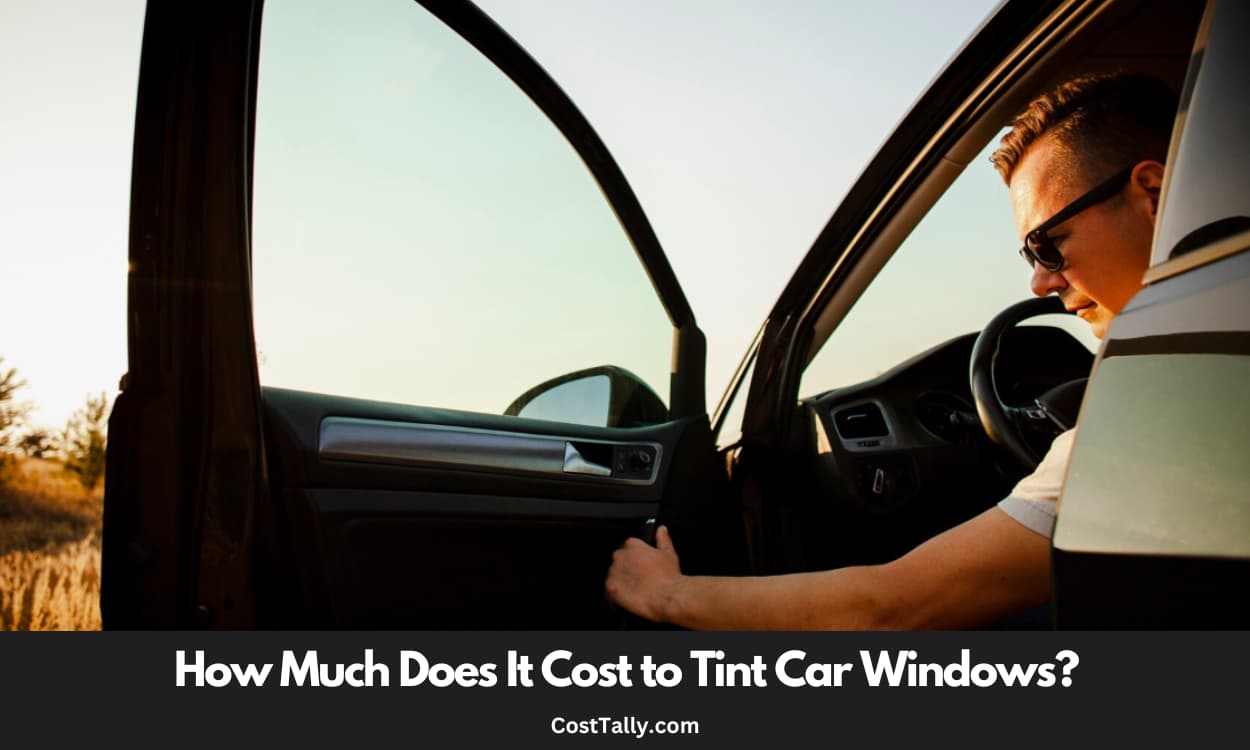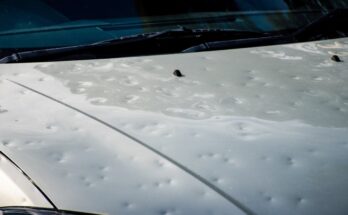Are you thinking about adding some tint to your car windows? You’re not alone! Many car owners are looking to tint their windows for privacy, style, and sun protection.
But before you jump in, it’s important to understand how much it might cost you in 2024.
How Much Does It Cost to Tint Car Windows?

In this article, we’ll break down everything you need to know about car window tinting prices, from basic options to high-end choices.
Why Tint Your Car Windows?
Before we dive into the nitty-gritty of costs, let’s take a quick look at why so many people choose to tint their car windows:
- Privacy: Tinted windows make it harder for others to see inside your car. This can be great for keeping your belongings out of sight and feeling more secure when you’re parked or driving.
- Sun protection: Good quality tint blocks harmful UV rays. This not only protects your skin while driving but also helps prevent your car’s interior from fading or cracking due to sun exposure.
- Glare reduction: Tinted windows can significantly reduce annoying glare from the sun, other car headlights, or reflective surfaces. This makes driving safer and more comfortable.
- Style: Let’s face it – many people think tinted windows look cool. They can give your car a sleek, sophisticated appearance.
- Energy savings: By keeping your car cooler in hot weather, you might find yourself using less air conditioning. This can lead to better fuel efficiency over time.
- Shatter protection: Some types of window tint can hold shattered glass together, potentially reducing injury in case of an accident.
Now that we understand the benefits, let’s talk money!
Factors That Affect Window Tinting Costs
The price of tinting your car windows can vary quite a bit. Here are the main factors that affect how much you’ll end up paying:
- Type of car: Bigger cars with more windows will naturally cost more to tint. An SUV will be pricier to tint than a small coupe.
- Tint brand: Just like with most products, some brands are pricier than others. Well-known brands with a good reputation often charge more.
- Tint material: Different types of tint (like ceramic, carbon, or dyed) have different prices. We’ll dive into these differences later.
- Number of windows: More windows mean more material and labor, which increases the cost.
- Window size and shape: Tricky windows, like curved rear windows or unusually shaped side windows, take more time and skill to tint properly. This can bump up the price.
- Who’s doing the job: Prices can vary widely between professional shops, mobile tinting services, and DIY kits.
- Where you live: Tinting costs can be higher or lower depending on your location. Prices in big cities are often higher than in smaller towns.
- Warranty: Tints with better warranties often come with a higher price tag.
- Time of year: Some shops might offer discounts during slower seasons.
- Additional services: If you’re getting other work done at the same time (like paint protection film), you might be able to negotiate a package deal.
Average Window Tinting Prices By Car Type
Let’s break down the rough price ranges you might expect for different types of vehicles:
Sedans (4-Door Cars)
Sedans are one of the most common types of cars on the road. Here’s what you might expect to pay:
- Basic tint: $250 – $400 for all windows
- High-end tint: $500 – $800 for all windows
For a standard sedan, you’re typically looking at tinting five windows: the two front side windows, two rear side windows, and the rear windshield. Some people also choose to add a strip of tint to the top of the front windshield, which can add to the cost.
Coupes (2-Door Cars)
Coupes often have larger side windows than sedans, which can affect the price:
- Average cost: $120 – $450 for all windows
Note: Steep or curved rear windows, which are common in sports coupes, can increase the price. These windows are trickier to tint and may require more skill and time.
Trucks
Pickup trucks have their considerations when it comes to tinting:
- Average cost: $350 – $500 for standard windows
This typically covers the two front windows and the rear window. If your truck has a sliding rear window, tinting it will add to the cost. Some trucks also have small side windows behind the main doors, which would also increase the price if tinted.
SUVs
SUVs generally cost more to tint due to their larger size and number of windows:
- Average cost: $250 – $750 for all windows
The wide range here is because SUVs can vary greatly in size, from compact models to large, three-row vehicles. The more windows and the larger they are, the higher the cost will be.
Tesla Models
Tesla vehicles have gained popularity, and many owners want to tint them. Here’s what you might expect:
- Average cost: $250 – $935 for all-around tint
Prices for Teslas can be on the higher end because of their large glass areas, including panoramic roofs on some models. Some Tesla owners choose to tint the roof glass as well, which can significantly increase the cost.
Remember, these are just rough estimates. Your actual cost might be different based on the factors we talked about earlier. It’s always a good idea to get quotes from several reputable shops in your area to get a more accurate idea of local prices.
Cost By Tint Type
The material used in your window tint makes a big difference in both price and quality. Let’s take a closer look at the main types of tint available:
Dyed Window Tint
- Cost range: $99 – $350
- Pros:
- Cheapest option
- Provides basic sun blocking
- Gives windows a dark appearance
- Cons:
- Fades quickly, often turning purple or brown over time
- Doesn’t block heat very well
- May bubble or peel more easily than higher-quality tints
Dyed window tint is the most basic and affordable option. It works by adding a layer of dye to the window film. This dye absorbs some sunlight, which helps reduce the amount of light and heat entering your car.
However, because it’s just a dye, it doesn’t offer the best heat rejection or longevity.
Carbon Window Tint
- Cost range: $150 – $450
- Pros:
- Better heat blocking than dyed tint
- Doesn’t fade as fast as dyed tint
- Matte finish that some people prefer
- Cons:
- Can create glare in some lighting conditions
- Might look slightly hazy, especially at night
- More expensive than dyed tint
Carbon window tint contains tiny carbon particles. These particles are good at blocking infrared light, which is responsible for much of the heat that enters your car. Carbon tint is more durable than dyed tint and won’t fade as quickly.
Ceramic Window Tint
- Cost range: $350 – $850
- Pros:
- Best heat and UV blocking
- Doesn’t interfere with electronic signals (cell phones, GPS, etc.)
- Very durable and long-lasting
- Provides the clearest view
- Cons:
- Most expensive option
Ceramic window tint is the top-of-the-line choice. It uses ceramic particles that are excellent at blocking heat and UV rays without blocking visible light or electronic signals. While it’s the most expensive option, many people find the benefits worth the cost.
Hybrid Tints
Some companies, like Rayno, make tints that combine different materials. These can offer a mix of benefits at various price points. For example:
- Nano Carbon-Ceramic: This type of tint aims to provide the heat rejection of ceramic tint with the affordability of carbon tint.
- Metallic-Dyed: These tints combine metal particles with dye to improve heat rejection over basic dyed tints, while still being more affordable than full ceramic options.
When choosing a tint type, consider your budget, but also think about the long-term benefits. While ceramic tint is more expensive upfront, its superior performance and durability might save you money in the long run.
Other Things That Affect Tinting Costs
Window Complexity
Some cars have windows that are harder to tint. This can add to the cost because it requires more time and skill from the installer. Examples of cars with tricky windows include:
- VW Beetle: The curved rear window can be challenging.
- Corvette Z06: The large, curved rear window is notoriously difficult to tint.
- Audi A8: The complex curves and large windows require extra care.
If your car has unusually shaped or very large windows, expect to pay a bit more for tinting.
Warranty
Tints with longer warranties usually cost more. When considering warranty options, ask these questions:
- How long does the warranty last?
- What exactly does it cover? (Fading, bubbling, peeling, etc.)
- Is it transferable if you sell your car?
- Does the warranty cover removal and reapplication if there’s a problem?
A good warranty can provide peace of mind, but make sure you understand what you’re paying for.
Location and Laws
Where you live affects tinting costs in two important ways:
- Local prices: Tinting might cost more in big cities or areas with a higher cost of living. On the flip side, areas with lots of competition between tint shops might have better prices.
- Tint laws: Each state has its laws about how dark your tint can be. These laws usually specify the minimum amount of light that must be able to pass through your windows. For example:
- California: Front side windows must allow more than 70% of light in. There’s no limit for rear side windows and rear windshield.
- Florida: Front side windows must allow more than 28% of light in. Rear side windows and rear windshields must allow more than 15% of light in.
- New York: Front side windows must allow more than 70% of light in. There’s no limit for rear side windows and rear windshield.
Make sure you know your local laws before getting your windows tinted. A reputable tint shop should be familiar with these regulations and can help you choose legal tint darkness.
DIY Tinting: Can You Save Money?
You might be wondering if you can save some cash by tinting your windows. While it’s possible, there are several things to consider:
Pros of DIY Tinting:
- Can be cheaper upfront (kits often cost $50-$100)
- Sense of accomplishment from doing it yourself
- You can do it on your schedule
Cons of DIY Tinting:
- Requires special tools and skills
- Easy to make mistakes (bubbles, uneven tint, debris under the film)
- Might not look as good as professional work
- You have to make sure you follow local tint laws
- Might void your car’s warranty
- No warranty on the work itself
- Can be very time-consuming, especially for beginners
For most people, professional tinting is worth the extra cost. You’ll get better results, a warranty on the work, and avoid potential headaches. Plus, if something goes wrong, the shop can fix it for you.
How to Get the Best Deal on Window Tinting?
Want to save money on your window tint? Try these tips:
- Get multiple quotes: Ask at least 3 shops for prices. This will give you a good idea of the going rate in your area.
- Look for specials: Some shops offer deals during slow seasons (often fall or winter) or for first-time customers.
- Bundle services: If you’re getting other work done (like paint protection film or car detailing), ask if there’s a discount for bundling services.
- Ask about different tint options: There might be a good mid-range choice that balances quality and affordability.
- Check online reviews: Make sure you’re getting quality work for your money. Sometimes the cheapest option isn’t the best value in the long run.
- Consider the long-term benefits: While ceramic tint is more expensive up front, its superior heat rejection might save you money on fuel (from using less A/C) over time.
- Ask about price matching: Some shops might be willing to match a competitor’s price for the same quality of tint.
- Look for newer shops: Established shops with a great reputation can charge premium prices. A newer shop might offer lower prices to build their customer base.
- Avoid very low prices: If a price seems too good to be true, it probably is. Very cheap tints might not last long or could damage your windows.
- Time it right: Some shops might be more willing to negotiate prices during slower periods.
The Tinting Process: What to Expect?
If you’ve never had your car windows tinted before, you might be wondering what the process involves. Here’s a general overview:
- Cleaning: The windows are thoroughly cleaned inside and out to remove any dirt or oils.
- Measuring and cutting: The tint film is measured and cut to fit each window precisely.
- Application: The film is carefully applied to the inside of the window, using water and a special solution to help it adhere.
- Squeegee: A squeegee is used to remove air bubbles and excess water.
- Heat shrinking: For curved windows, heat is applied to shrink the film to fit the contours perfectly.
- Drying: The tint needs time to dry and adhere fully. This usually takes a few days.
The entire process typically takes 2-4 hours for a standard car but can be longer for larger vehicles or more complex jobs.
Caring for Your New Window Tint
To get the most out of your investment, you’ll need to take care of your new tint:
- Wait before rolling down windows: Keep windows up for at least 3-5 days after installation.
- Avoid washing: Don’t wash your car for at least a week after tinting.
- Be gentle: When you do clean the windows, use soft materials and non-ammonia cleaners.
- Watch for bubbles: Small bubbles often disappear as the tint dries. If large bubbles persist after a week, contact your installer.
- Protect from scratches: Be careful not to scratch the tint, especially in the first few weeks when it’s most vulnerable.
FAQs:
- Q: How long does window tinting last?
A: Good quality tint can last 5-10 years or even longer with proper care. Ceramic tints tend to last the longest.
- Q: Will tinting void my car’s warranty?
A: Usually not, but it’s always a good idea to check with your dealer to be sure. Professional installation is less likely to cause warranty issues than DIY tinting.
- Q: Can I get just one or two windows tinted?
A: Yes, but it might look odd. Many people tint all side and rear windows for a uniform look. Also, some shops have a minimum charge that might make tinting just one window less cost-effective.
- Q: How long does it take to tint car windows?
A: Usually 2-4 hours for a professional job, depending on the car. Larger vehicles or more complex jobs might take longer.
- Q: Can I wash my car right after getting tints?
A: It’s best to wait at least a week to let the tint fully cure before washing. When you do wash, be gentle and avoid ammonia-based cleaners.
- Q: Does window tint reduce heat in my car?
A: Yes, especially higher-quality tints like ceramic. A good tint can significantly reduce the heat that enters your car through the windows.
- Q: Can I tint my front windshield?
A: In most states, you can only tint a strip at the top of the front windshield. Full front windshield tinting is usually not legal for passenger vehicles.
- Q: Will window tint interfere with my electronic devices?
A: High-quality modern tints, especially ceramic tints, should not interfere with cell phones, GPS, or other electronic signals.
- Q: How dark can I legally tint my windows?
A: This varies by state. Check your local laws or ask a reputable tint shop about legal tint darkness in your area.
- Q: Can the tint be removed if I don’t like it?
A: Yes, tint can be removed, but it’s a time-consuming process that might cost as much as the original tinting. It’s best to choose a tint you’re sure about from the start.
More Useful Automobile Costing Guides:
- How Much Does it Cost to Paint a Car Hood
- How Much Does Apple Carplay Installation Cost
- How Much Does It Cost To Build A Lowrider
- How Much Does It Cost To Patch A Tire At Firestone
- How Much Does It Cost To Wrap A Honda Civic
- How Much Does Quick Quack Car Wash Cost
- How Much Does It Cost To Return A Uhaul At A Different Location
- How Much Does It Cost To Replace A Steering Coupler
Conclusion:
Tinting your car windows can be a great investment, offering benefits like privacy, UV protection, and improved aesthetics.
In 2024, expect to pay anywhere from $100 to $850 or more, depending on your car type and the quality of tint you choose.
While cost is important, don’t forget to consider long-term benefits and local laws when making your decision.
Professional installation often provides the best results and peace of mind. Remember to care for your new tint properly to maximize its lifespan.
With the right tint and proper maintenance, you can enjoy a cooler, more comfortable, and stylish ride for years to come.



